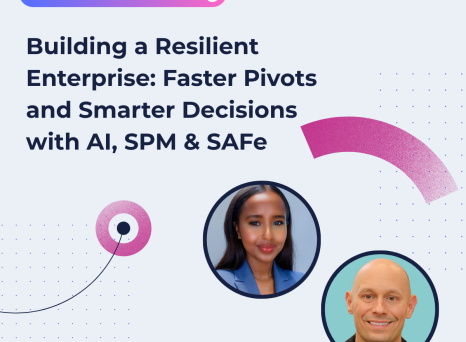Transformation projects, whether Agile, Digital or other, are all the rage. But the more conversations there are about transformations - why they are important, how to do them… - the more difficult it is to tell best practice from myth (and the bigger the mythology grows). Planisware was delighted to sponsor a recent episode of the PMO Strategies podcast where Jesse Fewell dug into a couple of the most damaging Transformation myths, including the conventional wisdom that transformations “should” be big bang.
Agile Transformation never plays out the way conventional wisdom says it will
If we say “Agile Transformation process”, what scenario comes to your mind?
Something like this?: One morning, the PMO or the Center of Excellence leader is told that they need to “Do an Agile transformation.” They immediately dive into the topic, read all the books, get certified (or even several certifications). This accumulated knowledge forms the foundation of their credibility, and gives them carte blanche to explain to everybody what Agile is and what the new organization should look like; why the current organization is all wrong; and how this new revolutionary way of doing things is so much better.
However, to realize this new vision of the organization, they must first secure the approval of the big boss. So they will score a 15 minute slot at the next senior leadership meeting, and do a big presentation on how the organization needs to go BIG with this transformation, using these new best practices, and how they should go ALL-IN on the project (also known as a “big bang transformation”).
The presentation is awesome, the CTO or the CIO immediately sees the logic of the methodology and says “This is brilliant. I hereby mandate everyone to do this, and we're all going to be Agile this time next year.” And there everybody goes “Yes, sir/ma'am. Absolutely.” And it all just happens: the company's fixed. And the PMO / Center of Excellence leader gets a promotion.
Only, in the real world, things never happen this way.
Instead, nobody at the senior leadership meeting agrees that there is any need for change. The big boss doesn't get it, and says very calmly “Thank you so much for your time.” The PMO / Center of Excellence leader has blown their credibility. Meanwhile their boss is embarrassed because they threw all of their chips on the table, and now they are the lame duck.
Another (worse) scenario is that the PMO / Center of Excellence leader is smart enough not to blow all their credibility. Instead, they quietly suffer through all the push-back and the changing of direction. As time goes by, they watch on as the Agile transformation falls apart, along with their mandate, their credibility, and sometimes, their PMO.
In other words: the classic expectation of how the transformation process will play out, based on what conventional wisdom has told them is fundamentally, catastrophically wrong.
The frustrating thing is that, in the vast majority of cases, the PMO / Center of Excellence leader genuinely means well. They identified a need for the organization to pivot, to become more flexible and more nimble by embracing Agile methodologies. They are trying to do the right things. They want to contribute and become more relevant to the organization. So they bite the bullet and decide to lead that change. But conventional wisdom sends them in the opposite direction of where success lies.
Big bang approaches to change do not work very well
The challenge with big bang approaches is that they assume that, because the big boss has mandated the change, magically, everyone will follow suit, and the organization will become Agile pretty much overnight.
The truth is that huge change management is really hard to do. In particular, the scale of the change that must be accomplished makes it very hard to bring people through the change process.
Part of the difficulty comes from the assumption (which underlies big bang approaches) that one-size fits all: that offering the same answer, the same approach to everyone in every situation is the way to go. But in real life, everyone has different motivators. No two people have exactly the same challenges, or find themselves in the same situation.
If a big bang approach does not work, then what does?
Stop explaining, start listening
It can be tempting to jump in straight away, and show the senior leader that comes in with a request for Agile transformation that you're on the ball, and you will make it happen.
But the best change leaders are the ones that step back from the request and ask “Why?” “Why are we doing this? What are the outcomes we are looking for?” “Is it more productivity? Is it more predictability? Is it more visibility in the organization? What does success look like?”
The senior leader might then say something like: “We need to be more efficient.”
Dig deeper. “When you say we need to be more efficient, does that mean layoffs? Because usually when economists are talking about efficiency and productivity, they are talking about man hours. Does success mean overtime?”
In other words: Successful change leaders probe. They understand that when somebody says “I want X.”, there's almost always an X' or X0 underneath that request.
So stop explaining: “It going to be this, and this and this.” And start asking “What are the outcomes we're looking for?”
Why? Because an Agile methodology that optimizes for speed is not the same as an Agile methodology that optimizes for predictability: if you want predictability, then you're going to under-commit and over-deliver. But if you want speed, dates are going to be very flexible, because if you want to go fast, you're going to hit or miss a couple of times.
If you take people at their word in that first conversation, then you might go in a completely different direction than if you ask the right questions and have an in-depth conversation.
So stop explaining, start listening, and design the change around the true intents.
Stop doing change to people, and start doing change with people
Another way in which asking questions makes a big difference for change management is that by genuinely listening to the answers, trying to see things from their perspective, the change leader starts pulling in their “constituents” into the transformation process.
Projecting an attitude of “This is the medicine you need to take.” “We know what's best for you.” is the surest way to raise people's hackles up and fight change. When people feel like change is happening to them, from external forces, as a singular event, there's much more friction.
On the other hand, continually delivering a message of “This is an ongoing journey” and “We're all part of it” puts people back at the center of the transformation, and can work miracles into obtaining the change you're aiming for.
This extends to the words you use: William Bridges in his book Managing Transitions recommends renaming the initiative from “Change” to “Transition”. By using a different word, you get the opportunity to define what it means, and stay away from the heavy negative connotations that “change” or “transformation” can bring.
A big vision with small, incremental actions
So why is it that people are still trying to bring about change using big bang approaches when these have repeatedly failed to deliver results?
One reason could be that change leaders often confuse a big vision with big action. And you can have one without the other: a big change without vision feels like just a lot of noise, chaos and craziness. That's when people look to the PMO and “What on earth are you doing? Why are you imposing this new template, this new methodology?”. Symmetrically, you can also have a big vision without meaningful action.
The secret to success is big vision with small wins that gradually build up into a series of reinforcing opportunities, and reinforcing wins.
Small wins are like compound interest.
However, these micro-transformations are not easy: it's hard, it takes patience, courage, the ability to communicate and inspire, and to keep people on the slog for the long haul.
We absolutely need a big vision. That's what our sponsors do, our senior leaders do, and we can coach them to come up with that vision. To communicate it, and to articulate it. But if we go too big, too fast, we're going to exceed the change tolerance of the organization, we're going to miss a ton of opportunities.
Big vision does not mean big action straight away. In the real world, change takes time.
There wasn't enough space for us to go over all the great insights from Jesse's latest podcast episode. To learn more about why the PMO will never run like clockwork, why you should invest in leadership development (minute 29:30), what makes Agile transformations different from other types of transformation, and for examples of successful Agile transformations piloted by the PMO (minute 13:50) listen to the whole episode on the PMO Strategies podcast.


